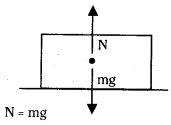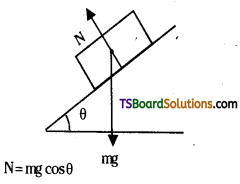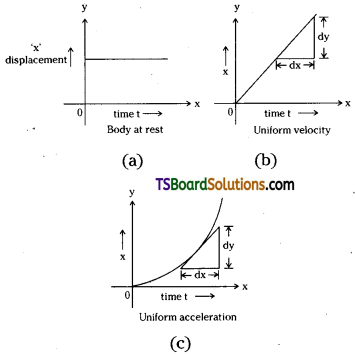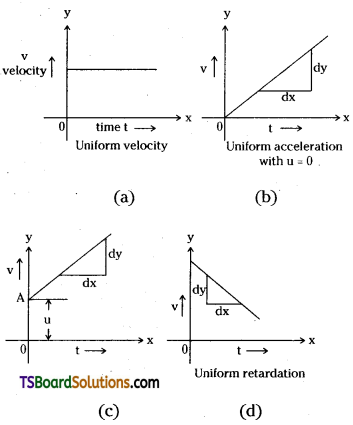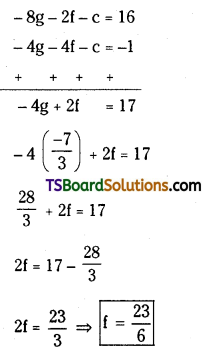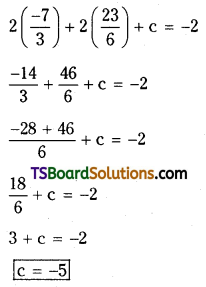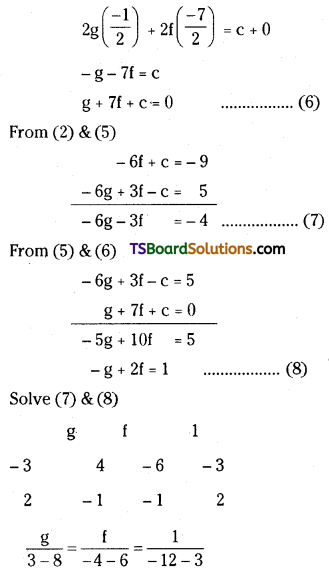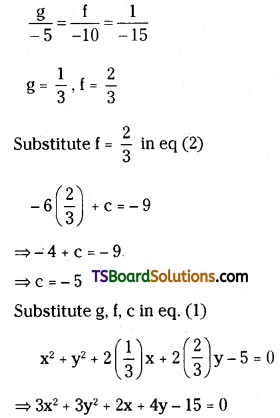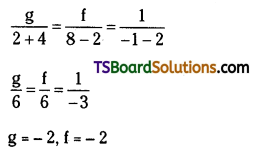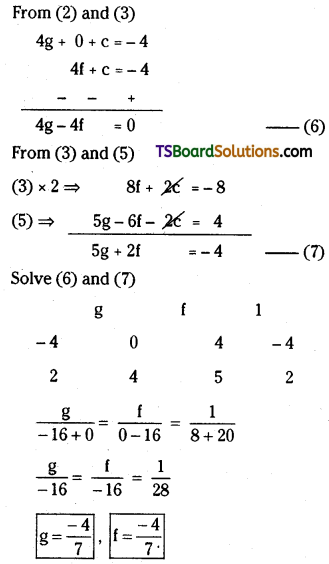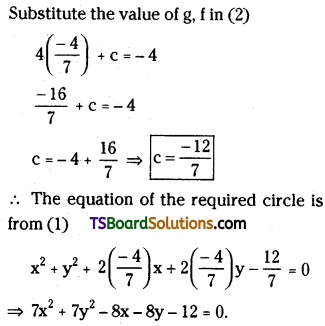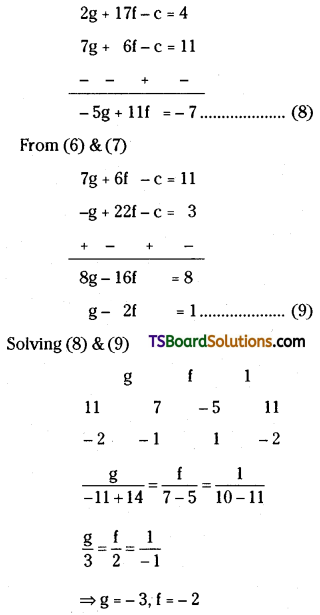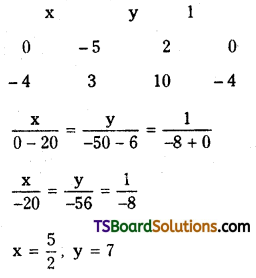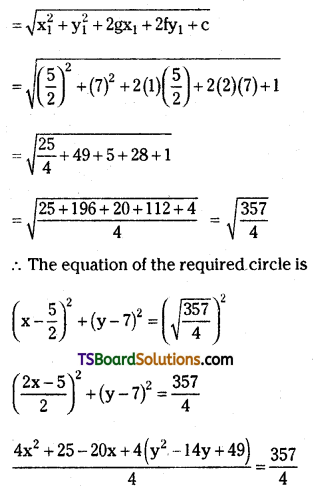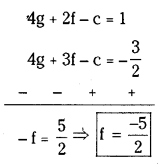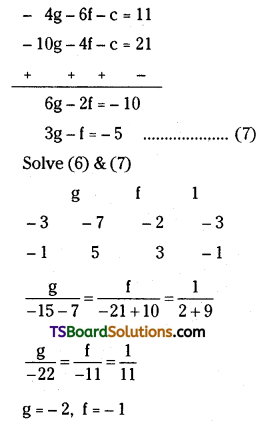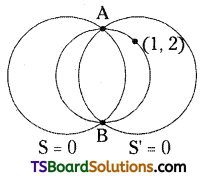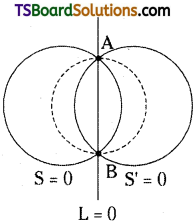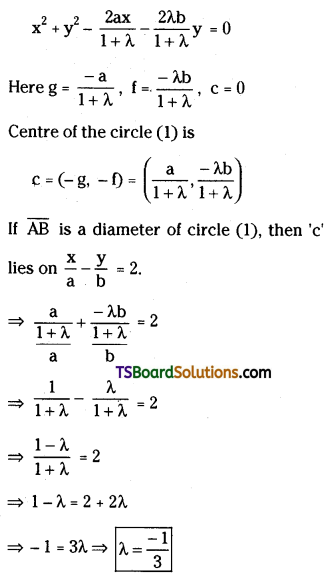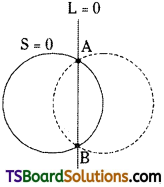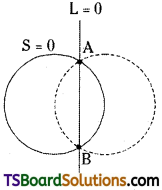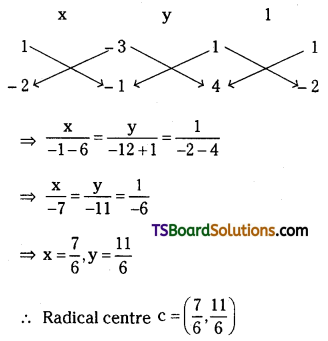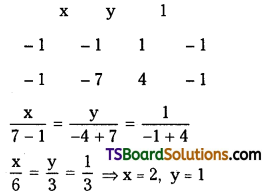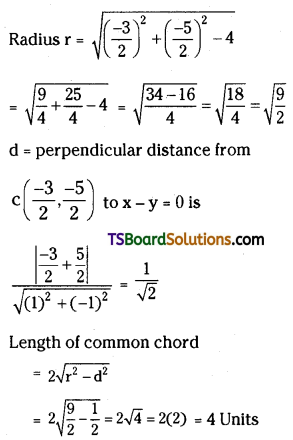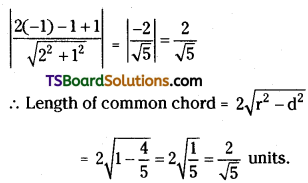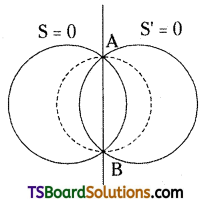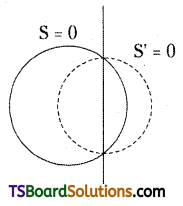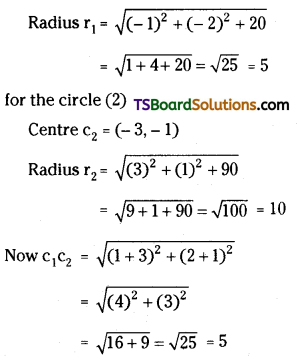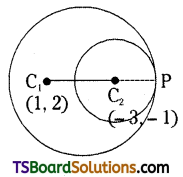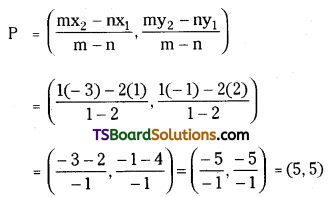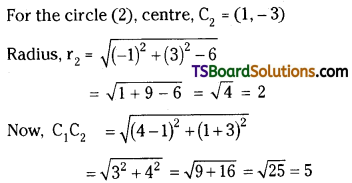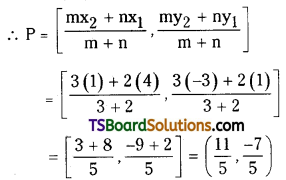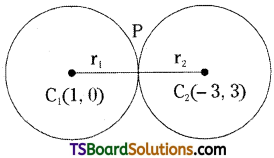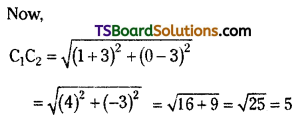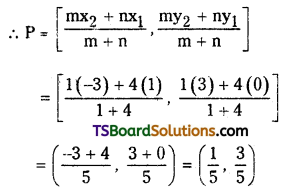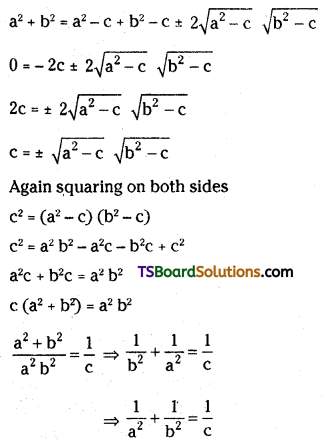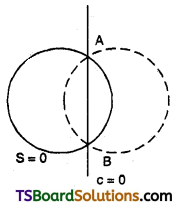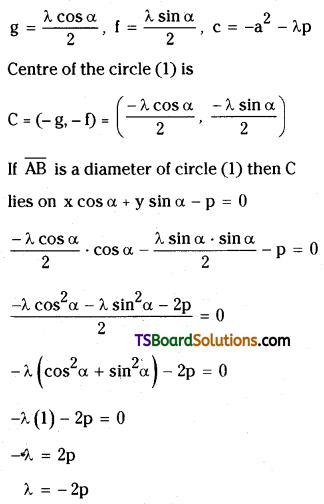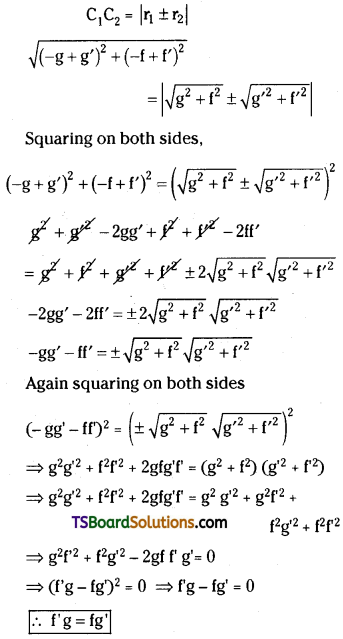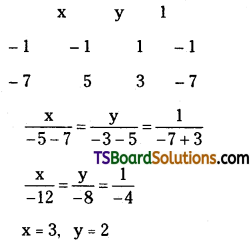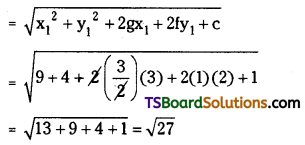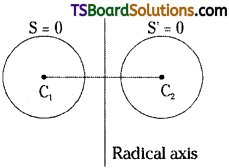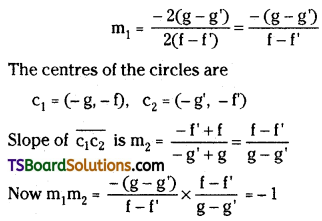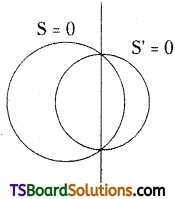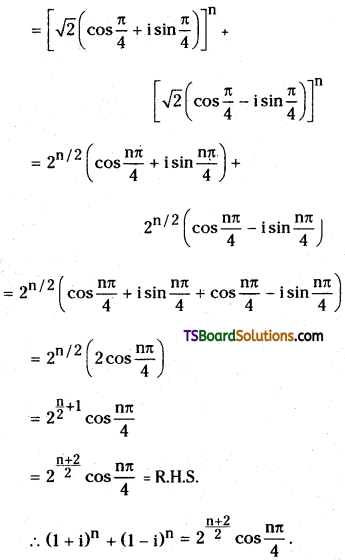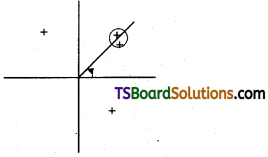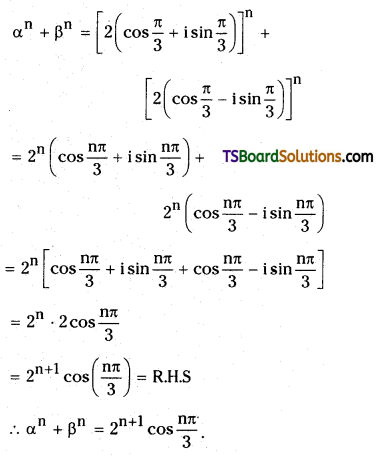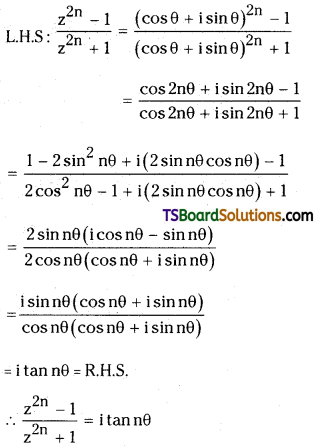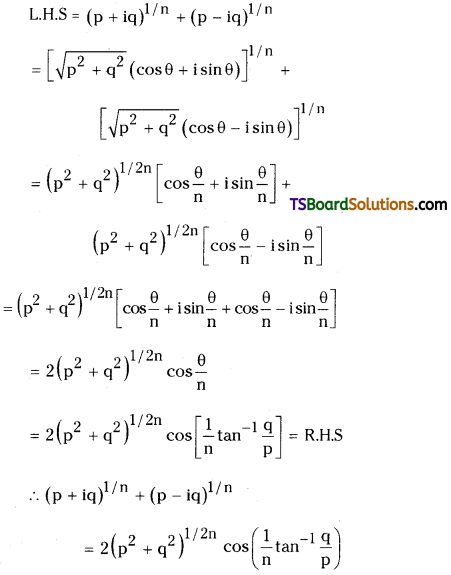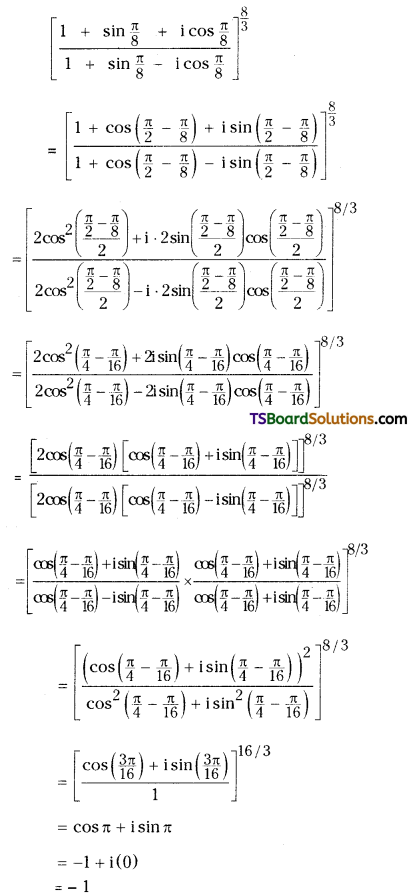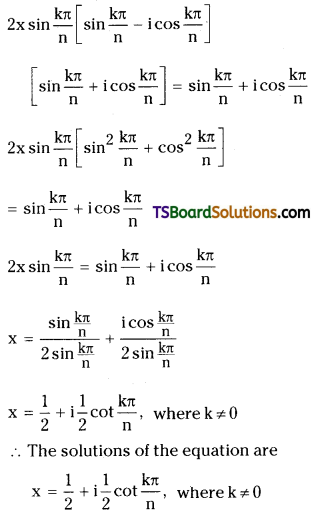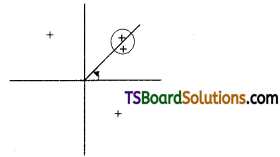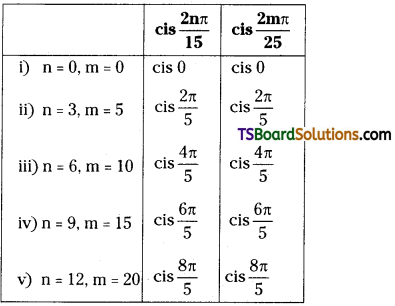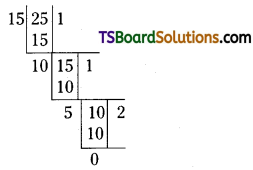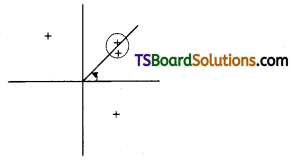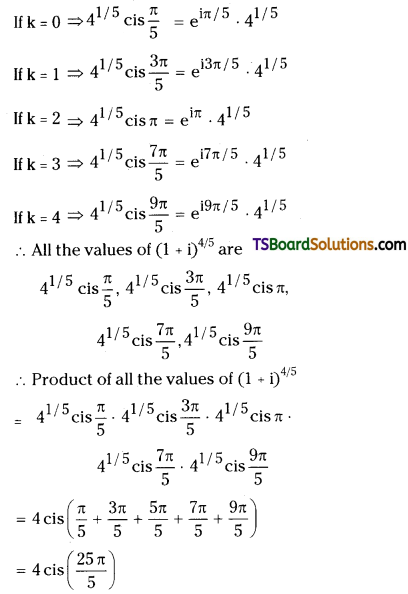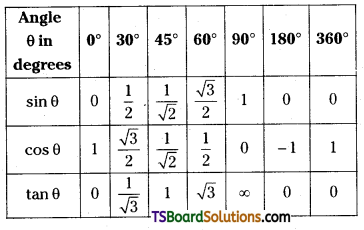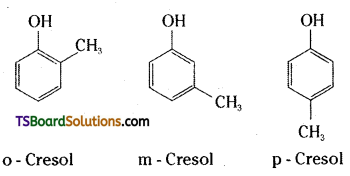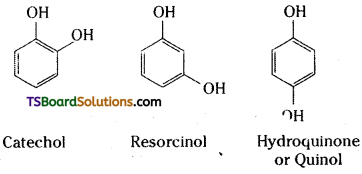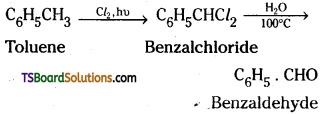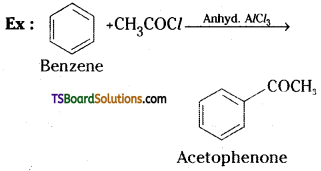Students must practice these Maths 2A Important Questions TS Inter Second Year Maths 2A Quadratic Expressions Important Questions Very Short Answer Type to help strengthen their preparations for exams.
TS Inter Second Year Maths 2A Quadratic Expressions Important Questions Very Short Answer Type
Question 1.
Find the roots of the quadratic equation ax2 + bx + c = 0. [March ’02]
Solution:
Given quadratic equation is ax2 + bx + c = 0
Now, multiplying with ‘4a’ on both sides
4a (ax2 + bx – c) = 0
= 4ax2x2 + 4abx + 4ac = 0
(2ax)2 + 2 . 2ax . b + b2 + b2 – b2 + 4ac = 0
(2ax + b)2 = b2 – 4ac
2ax + b = ± \(\sqrt{b^2-4 a c}\)
2ax = – b ± \(\sqrt{b^2-4 a c}\)
x = \(\frac{-b \pm \sqrt{b^2-4 a c}}{2 a}\)
∴ The roots of the quadratic equation, ax2 + bx + c = 0 are \(\frac{-b \pm \sqrt{b^2-4 a c}}{2 a}\).
Question 2.
Fmd the roots of the following equation √3x2 + 10x – 8√3 = 0.
Solution:
Given quadratic equation is √3x2 + 10x – 8√3 = 0
Comparing this with ax2 + bx + c = 0,
we have a = √3, b = 10 c = – 8√3
The roots of quadratic equation are \(\frac{-b \pm \sqrt{b^2-4 a c}}{2 a}\)
= \(\frac{-10 \pm \sqrt{100+96}}{2 \sqrt{3}}=\frac{-10 \pm \sqrt{196}}{2 \sqrt{3}}\)
= \(\frac{-10 \pm 14}{2 \sqrt{3}}=\frac{-10+14}{2 \sqrt{3}} \text { (or) } \frac{-10-14}{2 \sqrt{3}}\)
= \(\frac{4}{2 \sqrt{3}} \text { (or) } \frac{-24}{2 \sqrt{3}}=\frac{2}{\sqrt{3}} \text { (or) } \frac{-12}{\sqrt{3}}\)
= \(\frac{2}{\sqrt{3}}\) (or) – 4√3
∴ The roots of the quadratic equation are \(\frac{2}{\sqrt{3}}\) (or) – 4√3
Question 3.
Form a quadratic equation whose roots are 7 ± 2√5. [TS – May ’16; March ’11, ’05, AP – March 2018]
Solution:
Let α = 7 + 2√5, β = 7 – 2√5
Now, α + β = 7 + 2√5 + 7 – 2√5 = 14
αβ = (7 + 2√5) (7 – 2√5)
= 49 – 20 = 29
The quadratic equation whose roots are α, β is
x2 – (α + β)x + αβ = 0
x2 – 14x + 29 = 0.
![]()
Question 4.
Form a quadratic equation whose roots are – 3 ± 5i.
Solution:
Let α = – 3 + 5i, β = – 3 – 5i
Now, α + β = – 3 + 5i – 3 – 5i = – 6
αβ = (- 3 + 5i) (- 3 – 5i)
= 9 – 25i2 = 34
The quadratic equation whose roots are α, β is x2 – (α + β)x + αβ = 0
⇒ x2 + 6x + 34 = 0
Question 5.
Form a quadratic equation whose roots are \(\frac{p-q}{p+q}\), – \(\frac{p+q}{p-q}\) (p ≠ q).
Solution:
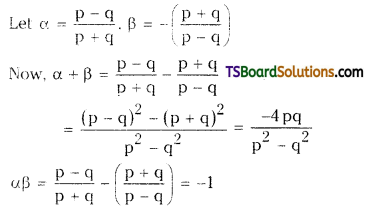
The quadratic equation whose roots are α, β is x2 – (α + β)x + αβ = 0
x2 + \(\frac{4 p q}{p^2-q^2}\) . x – 1 = 0
⇒ (p2 – q2)x2 + 4pqx – (p2 – q2) = 0
Question 6.
Find the nature of the roots of 4x2 – 20x + 25 = 0.
Solution:
Given quadratic equation is 4x2 – 20x + 25 = 0.
Comparing this with ax2 + bx + c = 0, we get
a = 4; b = – 20; c = 25
b2 – 4ac = 400 – 4 . 4 . 25 = 400 – 400 = 0
Since 2 – 4ac = 0 then the roots of the given equation are real and equal.
![]()
Question 7.
Find the nature of the roots of 2x2 – 8x + 3 = 0.
Solution:
Given quadratic equation is 2x2 – 8x + 3 = 0
Comparing this with ax2 + bx + c = 0, we get
a = 2, b = – 8, c = 3
Now, b2 – 4ac = 64 – 4 . 2 . 3
Since, b2 – 4ac > 0 then the roots of the given equation are real and distinct.
Question 8.
Find the nature of the roots of 2x2 – 7x + 10 = 0.
Solution:
Given quadratic equation is 2x2 – 7x + 10 = 0
Comparing this with ax2 + bx + c = 0, we get a = 2, b = – 7, c = 10
Now, b2 – 4ac = 49 – 80 = – 31 < 0
Since, b2 – 4ac < 0 then the roots of the given equation are conjugate complex numbers.
Question 9.
Find the nature of the roots of 3x2 + 7x + 2 = 0.
Solution:
Given quadratic equation is 3x2 + 7x + 2 = 0
Comparing this with ax2 + bx + c = 0, we get a = 3, b = 7, c = 2
Now, b2 – 4ac = 49 – 4 . 3 . 2
= 49 – 24 = 25 = 52 > 0
Since, b2 – 4ac > 0 then the roots of the given equation are rational and unequal.
![]()
Question 10.
If α, β are the roots of ax2 + bx + c = 0 then find \(\frac{1}{\alpha^2}+\frac{1}{\beta^2}\).
Solution:
If α, β are the roots of ax2 + bx + c = 0 then
α + β = \(\frac{-b}{a}\)
αβ = \(\frac{c}{a}\)
Now, \(\frac{1}{\alpha^2}+\frac{1}{\beta^2}=\frac{\beta^2+\alpha^2}{\alpha^2 \beta^2}=\frac{(\alpha+\beta)^2-2 \alpha \beta}{(\alpha \beta)^2}\)
= \(\frac{\left(\frac{-b}{a}\right)^2-2 \cdot \frac{c}{a}}{\left(\frac{c}{a}\right)^2}=\frac{b^2-2 c a}{c^2}\)
Question 11.
If α, β are the roots of ax2 + bx + c = 0 then find \(\frac{1}{\alpha}+\frac{1}{\beta}\). [March ’10]
Solution:
If α, β are the roots of ax2 + bx + c = 0
then α + β = \(\frac{-b}{a}\)
αβ = \(\frac{c}{a}\)
Now \(\frac{1}{\alpha}+\frac{1}{\beta}=\frac{\beta+\alpha}{\alpha \beta}=\frac{\frac{-b}{a}}{\frac{c}{a}}=\frac{-b}{c}\)
Question 12.
If α, β are the roots of ax2 + bx + c = 0 then find α2 + β2. [May ’13]
Solution:
If α, β are the roots of ax2 + bx + c = 0
then α + β = \(\frac{-b}{a}\), αβ = \(\frac{c}{a}\)
Now α2 + β2 = (α + β)2 – 2αβ
= \(\left(\frac{-b}{a}\right)^2-\frac{2 c}{a}=\frac{b^2}{a^2}-\frac{2 c}{a}=\frac{b^2-2 a c}{a^2}\).
![]()
Question 13.
For what values of m, the equation x2 – 15 – m (2x – 8) = 0 will have equal roots ?
[March ’13 ’04, May ’08, TS – Mar. 2015; AP – Mar. ’19,’17]
Solution:
Given equation is x2 – 15 – m (2x – 8) = 0
x2 – 15 – 2mx + 8m = 0
⇒ x2 – 2mx + 8m- 15 = 0 ……………(1)
Comparing this equation with
ax2 + bx + c = 0, we get
a = 1, b = – 2m, c = 8m – 15
Since (1) have equal roots
⇒ b2 – 4ac = 0
⇒ 4m2 – 4 (1) (8m – 15) = 0
⇒ 4m2 – 32m + 60 = 0
⇒ m2 – 8m + 15 = 0
⇒ m2 – 5m – 3m+ 15 = 0
⇒ m (m – 5) – 3 (m – 5) = 0
⇒ (m – 3) (m – 5) = 0
⇒ m = 3 (or) m = 5
∴ The values of m are 3, 5.
Question 14.
For what values of in, (m + 1) x2 + 2(m + 3) x + (m + 8) = 0 has equal roots? [March ‘03]
Solution:
Given quadratic equation is (m + 1) x2 + 2 (m + 3) x +(m + 8) = 0 …………..(1)
Comparing this with ax2 + bx + c = 0, we get
a = m + 1, b = 2 (m + 3), c = m + 8
Since (1) have equal roots then b2 – 4ac =0
⇒ [2 (m + 3)]2 – 4 (m + 1) (m + 8) = 0
⇒ 4 (m + 3)2 – 4(m + 1) (m + 8) = 0
⇒ m2 + 6m + 9 – m2 – 8m – m – 8 = 0
⇒ – 3m – 1 = 0 m = \(\frac{1}{3}\)
Question 15.
For what values of m, (3m + 1) x2 + 2(m + 1) x + m = 0 will have equal roots?
Solution:
Given quadratic equation is (3m + 1)x2 + 2(m + 1)x +m = 0 ………….(1)
Comparing this with ax2 + bx + c = 0, we get
a = 3m + 1, b = 2(m + 1), c = m
since (1) have equal roots then b2 – 4ac = 0
4 (m + 1)2 – 4m (3m + 1) = 0
m2 + 2m + 1 – 3m2 – m = 0
– 2m2 + m + 1 = 0
2m2 – m – 1 = 0
2m2 – 2m + m – 1 = 0
2m (m – 1) + 1 (m – 1) = 0
(m – 1) (2m + 1) = 0
m = 1, m = – \(\frac{1}{2}\)
![]()
Question 16.
Prove that the roots of (x – a) (x – b) = h2 are always real. [AP – May 2013, May ’09]
Solution:
Given quadratic equation is
(x – a) (x – b) = h2
⇒ x2 – ax – bx + ab – h2 = 0
⇒ x2 + (- a – b)x + ab – h2 = 0
Comparing this with ax2 + bx + c =0, we get
⇒ a = 1, b = – a – b, c = ab – h2
Now,
b2 – 4ac = (- a – b)2 – 4 (1) (ab – h2)
= a2 + b2 + 2ab – 4ab + 4h2
=(a2 + b2 – 2ab) + 4h2
= (a – b)2 + (2h)2 > 0
Since b2 – 4ac > 0 then the roots of the given equation are always real.
Question 17.
Find the quadratic equation, the sum of whose roots is 1 and sum of the sqares of the roots is 13. [May ’07]
Solution:
Let α, β be the roots of required equation.
Given that, the sum of roots, α + β = 1
Sum of squares of the roots, α2 + β2 = 13
We know that, (α + β)2 = α2 + β2 + 2αβ
⇒ 1 = 13 + 2αβ
⇒ 2αβ = – 12
⇒ αβ = – 6
∴ The quadratic equation whose roots are α, β is x2 – (α + β)x + αβ = 0
⇒ x2 – x – 6 = 0
Question 18.
Solve the equation 4x – 1 – 3 . 2x – 1 + 2 = 0. [March ’04]
Solution:
Given equation is 4x – 1 – 3 . 2x – 1 + 2 = 0
\(\frac{4^x}{4}-3 \cdot \frac{2^x}{2}+2\) = 0
\(\frac{\left(2^2\right)^x}{4}-3 \cdot \frac{2^x}{2}+2\) = 0
\(\frac{\left(2^x\right)^2}{4}-3 \cdot \frac{2^x}{2}+2\) = 0
Let 2x = a
⇒ \(\frac{\mathrm{a}^2}{4}-\frac{3 \mathrm{a}}{2}\) + 2 = 0
⇒ a2 – 6a + 8 = 0
⇒ a2 – 4a – 2a + 8 = 0
⇒ (a – 4) (a – 2) = 0
⇒ a = 4 (or) 2.
Case – I:
lf a = 4
⇒ 2x = 4
⇒ 2x = 22
⇒ x = 2.
Case – 2:
If a = 2
⇒ 2x = 2
⇒ x = 1
∴ The solution set of the given equation is {2, 1}.
![]()
Question 19.
Find the maximum or minimum of the expression 12x – x2 – 32 x varies over R.
Solution:
Given quadratic expression is – x + 12x – 32
Comparing this expression with ax + bx + c, we have a = – 1, b = 12, c = – 32
Here a = – 1 < 0.
Then – x2 + 12x – 32 has absolute maximum at x = \(\frac{-b}{2 a}=\frac{-12}{2(-1)}\) = 6
∴ The maximum value = \(\frac{4 a c-b^2}{4 a}\)
= \(\frac{4(-1)(-32)-144}{4(-1)}\)
= \(\frac{128-144}{-4}=\frac{-16}{-4}\) = 4.
Question 20.
If the quadratic equations ax2 + 2bx + c = 0 and ax2 + 2cx + b = 0, (b ≠ c) have a common root then show that a + 4b + 4c = 0.
Solution:
Given quadratic equations are ax2 + 2bx + c = 0
Comparing this equation with a1x2 + b1x + c1 = 0, we get
a1 = a, b1 = 2b, c1 = c
Now, a2x + 2cx + b = 0
Comparing this with a2x2 + b2x + c2 = 0
we get a2 = a, b2 = 2c, c2 = b
The condition for two quadratic equations
a1x2 + b1x + c1 = 0 and a2x2 + b2x + c2 = 0 to have a common root is
(c1a2 – c2a1)2 = (a1b2 – a2b1) (b1c2 – b2c1)
⇒ (ca – ba)2 = (a2c – a2b) (2bb – 2cc)
⇒ a2 (c – b)2 = 2a (c – b) 2 (b2 – c2)
⇒ a2 (c – b)2 = 4a (c – b) (b – c) (c – b)
⇒ a = – 4 (c + b) a = – 4c – 4b
a + 4b + 4c = 0.
Question 21.
If x2 – 6x + 5 = 0 and x2 – 12x + p = 0 have a common root, then find p. [TS – May 2015, Mar. 2017]
Solution:
Given quadratic equations are x2 – 6x + 5 = 0
Comparing this equation with
a1x2 + b1x + c1 = 0, we get
a1 = 1, b1 = – 6, c1 = 5
Now, x2 – 12x + p = 0,
Corn paring with a2x2 + b2x + c2 = 0
we get a2 = 1, b2 = – 12, c2 = p
The condition for two quadratic equations
a1x2 + b1x + c1 = 0 and a2x2 + b2x + c2 = 0 to have a common root is
(c1a2 – c2a1)2 = (a1b2 – a2b1) (b1c2 – b2c1)
(5 (1) – p(1))2 = (1 (- 12) – 1 (- 6)) ((- 6)p – (- 12) 5)
⇒ (5 – p)2 = – 6 (- 6p + 60)
⇒ p2 + 25 – 10p = 36p – 360
⇒ p2 – 16p + 385 = 0
⇒ p2 – 35p – 11p + 385 = 0
⇒ p (p – 35) – 11 (p – 35) = 0
⇒ (p – 11) (p – 35) = 0
⇒ p = 11 (or) p = 35
∴ p = 11 (or) 35.
![]()
Question 22.
For what values of x, the expression x2 – 5x + 6 is positive?
Solution:
The given quadratic expression is x2 – 5x + 6
⇒ x2 – 3x – 2x + 6 = x (x – 3) – 2 (x – 3) = (x – 2)(x – 3)
i) If 2 < x < 3 then the expression x2 – 5x + 6 is ‘- ve’.
ii) If x < 2 (or) x> 3 then the expression x2 – 5x + 6 is ‘+ ve’.
iii) If x = 2 (or) x = 3 then the expression x2 – 5x + 6 = 0
Question 23.
For what values of x, the expression x2 – 5x – 6 is negative? [March ‘95]
Solution:
Given quadratic expression is x2 – 5x – 6
= x2 – 6x + x – 6
= x (x – 6) + 1 (x – 6)
= (x + 1)(x – 6)
i) If – 1 < x < 6 then the expression x2 – 5x – 6 is ‘-ve’.
ii) If x < – 1 or x > 6 then the expression x2 – 5x – 6 is ‘+ ve’.
iii) If x = – 1 (or) x = 6 then the expression x2 – 5x – 6 = 0.
Question 24.
Discuss the signs of the expression x2 – 5x + 4 for x ∈ R. [May ’95].
Solution:
Given quadratic expression is x2 – 5x + 4
= x2 – 4x – x + 4
= x (x – 4) + 1 (x – 4)
= (x – 1) (x – 4)
i) If 1 < x < 4 then the expression x2 – 5x + 4 is ’-ve’.
ii) If x < 1 (or) x > 4 then the expression x2 – 5x + 4 is ’+ve’.
iii) If x = 1 (or) x = 4 then the expression x2 – 5x + 4 = 0.
Question 25.
Find the maximum or minimum value of the expression 12x – x2 – 32. [May ’06]
Solution:
Given quadratic expression is – x2 + 12x – 32 = 0
Comparing this expression with ax2 + bx + c, we have a = – 1, b = 12, c = – 32
Here, a = – 1 < 0.
Then – x2 + 12x – 32 has absolute maximum at x = \(\frac{-b}{2 a}=\frac{-12}{2(-1)}\) = 6
The maximum value = \(\frac{4 a c-b^2}{4 a}\)
= \(\frac{4(-1)(-32)-144}{4(-1)}=\frac{128-144}{-4}\)
= \(\frac{-16}{-4}\) = 4.
![]()
Question 26.
Find the maximum or minimum value of the expression 2x – 7 – 5x2. [May ’10. March ’14, ’12].
Solution:
Given quadratic expression is – 5x2 + 2x – 7
Comparing this expression with ax2 + bx + c,
we have a = – 5, b = 2, c = – 7
Here, a = – 5 < 0, – 5x2 + 2x – 7 has absolute maximum at
x = \(\frac{-b}{2 a}=\frac{-2}{2(-5)}=\frac{1}{5}\)
∴ Maximum value is \(\frac{4 a c-b^2}{4 a}=\frac{4(-5)(-7)-4}{4(-5)}\)
= \(\frac{140-4}{-20}=\frac{136}{-20}=\frac{-34}{5}\)
Question 27.
Find the maximum or minimum value of the expression 3x2 + 2x + 11. [May ’92]
Solution:
Given quadratic expression is 3x2 + 2x + 11
Comparing this expression with ax2 + bx + c, we have a = 3, b = 2, c = 11
Here, a = 3 >0, 3x2 + 2x + 11 has absolute minimum at
x = \(\frac{-b}{2 a}=\frac{-2}{2(3)}=\frac{-1}{3}\)
∴ The minimum value = \(\frac{4 a c-b^2}{4 a}=\frac{4(3)(11)-4}{4(3)}\)
= \(\frac{132-4}{12}=\frac{128}{12}=\frac{32}{3}\).
Question 28.
Find the maximum or minimum value of the expression x2 – x + 7 as x varies over R. [May ’14]
Solution:
Given quadratic expression is x2 – x + 7
Comparing this expression with ax2 + bx + c, we have a = 1, b = – 1, c = 7
Here, a = 1 > 0, x2 – x + 7 has absolute minimum at x = \(\frac{-b}{2 a}=\frac{-(-1)}{2 \cdot 1}=\frac{1}{2}\)
∴ The minimum value = \(\frac{4 a c-b^2}{4 a}=\frac{4(1)(7)-(-1)^2}{4(1)}\)
= \(\frac{28-1}{4}=\frac{27}{4}\)
![]()
Question 29.
Find the roots of the equation 6√5 x2 – 9x – 3√5 = 0.
Solution:
\(\frac{\sqrt{5}}{2}, \frac{-1}{\sqrt{5}}\)
Question 30.
Form a quadratic equation whose roots are 2√3 – 5 and – 2√3 – 5.
Solution:
x2 + 10x + 13 = 0.
Question 31.
Form a quadratic equation whose roots are \(\frac{\mathbf{m}}{\mathbf{n}}, \frac{-\mathbf{n}}{\mathbf{m}}\), (m ≠ 0, n ≠ 0)
Solution:
mnx2 – (m2 – n2)x – mn = 0
Question 32.
If α, β are the roots of ax2 + bx + c = 0 then find α3 + β3.
Solution:
\(\frac{3 a b c-b^3}{a^3}\)
![]()
Question 33.
For what values of m, x2 + (m + 3) x + (m + 6) = 0 will have equal roots?
Solution:
m = 3, – 5.
Question 34.
For what values of m, z2 – 2 (1 + 3m) x + 7 (3 + 2m) = 0 will have equal roots?
Solution:
m = 2, \(\frac{-10}{9}\).
Question 35.
For what vaIueof m, (2m+ 1)x2 + 2(m + 3)x + (m + 5) = 0 will have equal rooti?
Solution:
m = \(\frac{-5 \pm \sqrt{41}}{2}\)
Question 36.
Find the quadratic equation, the sum of whose roots is 7 and sum of the squares of the roots is 25.
Solution:
x2 – 7x + 12 = 0
![]()
Question 37.
So1ve the equation 31 + x + 31 – x = 10.
Solution:
{- 1, 1}
Question 38.
Solve 71 + x + 71 – x = 50 for real x.
Solution:
{- 1, 1}
Question 39.
If x2 – 6x + 5 = 0 and x2 – 3ax + 35 = 0 have a common root, then find a.
Solution:
4 (or) 2.
Question 40.
For what values of x, the expression x2 – 5x + 14 is positive?
Solution:
∀ x ∈ R
![]()
Question 41.
For what values of x, the expression 3x2 + 4x + 4 is positive?
Solution:
∀ x ∈ R
Question 42.
For what values of x, the expression x2 – 7x + 10 is negative?
Solution:
2 < x < 5
Question 43.
For what values of x, the expression 15 + 4x – 3x2 is negative? [AP – Mar. 2015]
Solution:
x < – \(\frac{5}{3}\) (or) x > 3.
![]()
Question 44.
Find the changes in the sign of 4x – 5x2 + 2 for x ∈ R.
Solution:
Positive for \(\frac{2-\sqrt{14}}{5}<x<\frac{2+\sqrt{14}}{5}\)
negative for x < \(\frac{2-\sqrt{14}}{5}\) (or) x > \(\frac{2+\sqrt{14}}{5}\)
